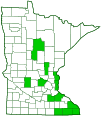spotted St. Johnswort
(Hypericum punctatum)
Conservation • Wetland • Description • Habitat • Ecology • Use • Distribution • Taxonomy
|
|
|||||||||||||||||||||||
Description |
Spotted St. Johnswort is an erect, perennial forb that rises on multiple stems from a woody rhizome. It can be 20″ to 40″ in height but is usually no more than 30″ tall. The stems are erect, hairless, leafy, and round in cross section. They have few if any branches below the inflorescence. They are green or red and are dotted with black glands. The leaves are opposite, oblong-elliptic, and stalkless. The larger leaves are 1½″ to 2⅜″ long and ⅜″ to ⅝″ wide. They are rounded to almost squared off at the tip and sometimes have a shallow notch at the tip. They are dotted with translucent glands visible when the leaf is held up to light. The upper surface is hairless. The lower surface is hairless and is dotted with many black glands. Between larger black glands there are numerous small, slightly paler, translucent spots. The margins are untoothed and dotted with many black glands. The inflorescence is a branched cluster of many flowers at the end of the stem and a few curved flowering branches rising from nodes immediately below. The terminal clusters together with the curved flowering branches form a usually small and crowded, flat-topped or rounded array (cyme). Each flower is subtended by a linear, ⅛″ long, modified leaf (bract). The flowers are small, 5 ⁄16″ to ⅝″ in diameter. There are 5 sepals, 5 petals, 30 to 60 stamens, and 3 styles. The sepals are green, egg-shaped to oblong, 1 ⁄16″ to ⅛″ long, and 1⁄32″ wide. They are broadly or moderately angled with straight sides along the tip. They are erect in bud, bent backward in flower. They are heavily dotted with black glands. The petals are yellow, oblong to elliptic, asymmetric, ⅛″ to ¼″ long, and about 1 ⁄16″ wide. There are numerous amber to black dots all over the petals, not just near the margins. The petals shrivel and turn brown but remain attached as the fruit develops. The stamens are in 3 groups. The anthers are yellow. The styles are 1 ⁄16″ to ⅛″ long. The stigmas are often reddish. The fruit is a nearly round to egg-shaped, ⅛″ to ¼″ long, 3-chambered capsule with numerous seeds. |
Height |
20″ to 40″ |
Flower Color |
Yellow |
Similar Species |
Common St. Johnswort (Hypericum perforatum) is a shorter plant, no more than 32″ tall, and is more branched. The stems are strongly angled and have two small longitudinal ridges. The branches are sharply ridged below the base of each leaf. The leaves are smaller, no more than 1¼″ long. The small translucent spots on the lower leaf surface are paler, more translucent. The inflorescence is larger and more open. The flowers are larger, up to 1″ in diameter. The sepals are acuminate and have few if any black glands. The petals have black dots only near the margin. Pale St. Johnswort (Hypericum ellipticum) has erect, unbranched stems and a few pale yellow flowers. |
Habitat |
Dry or moist. Fields, woodland edges and openings. Usually in partial sun. |
Ecology |
Flowering |
June to August |
Pests and Diseases |
|
Use |
|
Distribution |
||
|
Sources |
|
| 6/3/2025 | ||
Nativity |
||
Native |
||
Occurrence |
||
Locally common |
||
Taxonomy |
|
Kingdom |
|
Subkingdom |
Pteridobiotina |
Phylum |
Tracheophyta (Vascular Plants) |
Class |
|
Order |
Malpighiales (Nances, Willows, and Allies) |
Family |
Hyperiaceae (St. John’s wort) |
Tribe |
Hypericeae (St. John’s worts) |
Genus |
Hypericum (St. John’s worts) |
Section |
Hypericum |
Synonyms |
|
| Hypericum subpetiolatum | |
Common Names |
|
| spotted St. Johnswort | |
The common name refers to the blooming period. The plant is usually in bloom on June 24, St. John’s Day. |
|
Glossary
Acuminate
Gradually tapering with concave sides to a sharply pointed tip.
Bract
Modified leaf at the base of a flower stalk, flower cluster, or inflorescence.
Cyme
A branched, flat-topped or convex flower cluster in which the terminal flower opens first and the outermost flowers open last.
Linear
Long, straight, and narrow, with more or less parallel sides, like a blade of grass.
Node
The small swelling of the stem from which one or more leaves, branches, or buds originate.
Rhizome
A horizontal, usually underground stem. It serves as a reproductive structure, producing roots below and shoots above at the nodes.
Sepal
An outer floral leaf, usually green but sometimes colored, at the base of a flower.
Stigma
In plants, the portion of the female part of the flower that is receptive to pollen. In Odonata and Hymenoptera, a blood-filled blister or dark spot at the leading edge of each wing toward the tip, thought to dampen wing vibrations and signal mates. In Lepidoptera, an area of specialized scent scales on the forewing of some skippers, hairstreaks, and moths.
Style
On plants: Part of the pistil, usually a slender stalk, connecting the ovary to the stigma(s). On flies (Diptera): A terminal, often slender or pointed, appendage arising from the end of the last, usually third, antennal segment.
Visitor Photos |
||
Share your photo of this plant. |
||
This button not working for you? |
||
|
||
MinnesotaSeasons.com Photos |
||
|
||
|

Slideshows |
|

Visitor Videos |
||
Share your video of this plant. |
||
This button not working for you? |
||
|
Other Videos |
||
|

Visitor Sightings |
||
Report a sighting of this plant. |
||
This button not working for you? |
||
|
|
MinnesotaSeasons.com Sightings |
||

|
Created: 12/30/2013 Last Updated: © MinnesotaSeasons.com. All rights reserved. |
